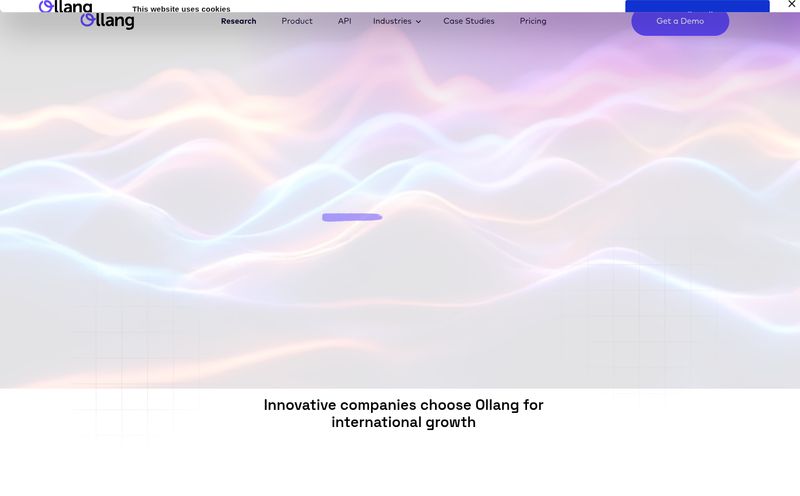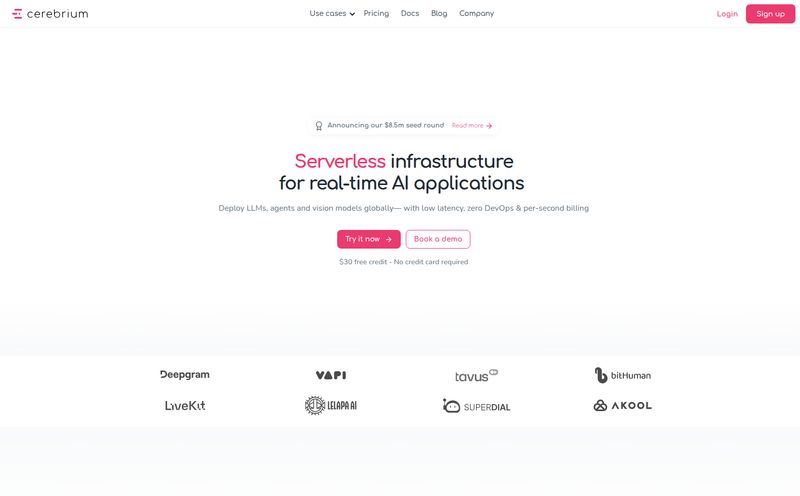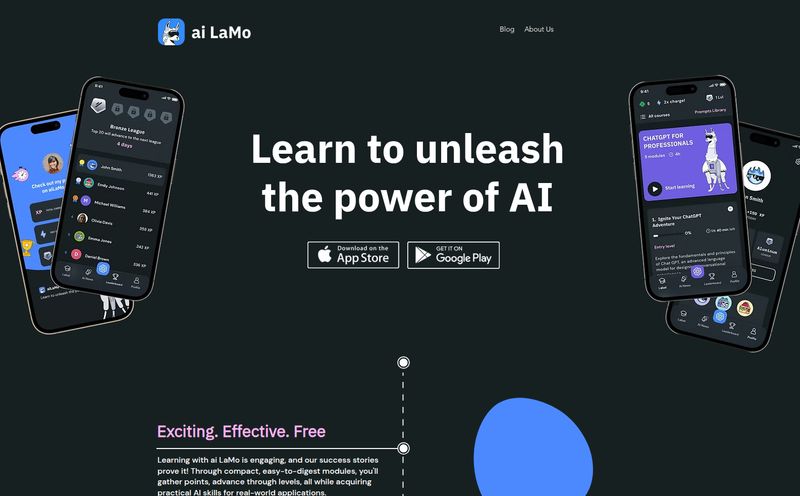I was digging through some old bookmarks the other day, doing a bit of digital spring cleaning, and I stumbled upon a link I’d saved: PlasticDB. The name rang a bell. I remembered the buzz around it—or at least, the buzz around tools like it. The promise was electrifying, one of those ideas that makes you smack your forehead and say, “Of course!”
The concept was simple, elegant even. A tool to let anyone, and I mean anyone, query a database using plain, simple English. No more wrestling with `SELECT FROM users WHERE signup_date > '2023-01-01' AND country = 'UK';`. Just… asking a question. It was supposed to be the great democratizer of data.
So, with a flicker of renewed curiosity, I clicked the link. And was met with a stark, dark blue screen. And in the top right corner, a bright orange banner that screamed, in all caps, “DOMAIN SALE.”
Well, that's a bit of a mood killer, isn't it?
It seems PlasticDB is no more. A ghost in the machine. But the story here isn’t just about a single defunct startup. It’s about the dream it represented, the problems it tried to solve, and why this particular holy grail is so darn difficult to grasp.
The Big Idea Behind PlasticDB
So what was PlasticDB supposed to be? At its heart, it was an AI-powered translator. Imagine you have a brilliant, all-knowing oracle who holds all your company’s secrets—sales figures, user behavior, inventory levels. The only problem? This oracle only speaks a weird, ancient dialect called SQL. To get any answers, you need a special, highly-trained priest (your data analyst) to interpret your questions.
PlasticDB promised to be your universal translator. You’d type in, “Hey, show me how many new users we got from our Facebook campaign in May,” and the AI would work its magic behind the scenes, converting your request into a perfectly formed SQL query and spitting back the answer. No analyst, no ticket queue, no waiting three days for a simple CSV file. It sounds like magic, and for a lot of teams, it would be.
Why a Tool Like PlasticDB Was (And Still Is) So Appealing
The excitement for a tool like this is real, and it comes from a place of deep, deep frustration that I’m sure many of you have felt. For years, we've been told to be “data-driven,” but for most people, the data is locked away in a fortress.
Tearing Down the "SQL Wall"
In almost every company I’ve worked with, there’s a bottleneck. It’s the data team. And that's no knock on them; they’re usually swamped with requests from every department. Marketing needs campaign performance metrics, sales wants to see lead conversion rates, product needs to track feature adoption. The result is what I call the “SQL Wall.” You throw your request over the wall and hope something useful comes back in a few days.
A tool that allows a product manager to directly ask, “What is the churn rate for customers who use feature X versus those who don’t?” is not just a time-saver. It’s a game-changer. It changes the speed of iteration and insight. It’s the difference between having an idea on Monday and getting the data to back it up on Tuesday, instead of next Friday.
Empowering the Entire Team
When data access is limited to a few specialists, a knowledge gap forms. The people on the front lines—the marketers, the support agents, the sales reps—have amazing instincts and contextual understanding, but they can't easily validate their hunches with hard numbers. Giving them direct access to data doesn't just make them faster, it makes them smarter and more autonomous. It fosters a culture of curiosity and ownership. That was the dream of PlasticDB.
The Hard Reality: Where AI-to-SQL Tools Can Falter
So if the idea is so brilliant, why is plasticdb.com up for sale? While I don’t have any insider info, I can tell you that building a tool like this is monstrously difficult. The path is littered with pitfalls that can turn a dream tool into a liability.
The "Lost in Translation" Problem
The first hurdle is accuracy. An AI's ability to write a correct SQL query depends entirely on its understanding of your database’s schema—the blueprint of your tables, columns, and how they relate. If your schema is perfectly named and documented (and let’s be honest, whose is?), it might work well for simple questions.
But what happens when the AI gets it wrong? A slight misinterpretation of a term like “active user” could lead to a report that’s off by millions. For simple queries like “total sales last month,” it’s probably fine. But for a complex, multi-join query that tries to correlate user behavior with lifetime value across six different tables? I've seen senior developers sweat over those. Trusting an AI to get that nuance right, every single time, is a massive leap of faith. The consequences of getting it wrong can be disastrous. A wrong number in a board meeting can do more damage than no number at all.
The Security Elephant in the Room
Okay, this is the one that keeps CTOs up at night. Giving an AI a direct line into your production database is… scary. How do you control permissions? With SQL, it’s relatively straightforward. You can grant a user `SELECT` access to specific tables.
But with natural language? What stops a user from innocently asking, “Can you list the names and emails of our highest-paying customers?” If the AI isn’t sophisticated enough to recognize that as a request for sensitive personally identifiable information (PII), you could have a major data breach on your hands. It’s a security nightmare. Properly sandboxing the AI and implementing granular, context-aware permissions is a monumental challenge.
So, What's the Deal with Pricing? (Or Lack Thereof)
Given the “for sale” sign, it's no surprise that the pricing information for PlasticDB is nonexistent. It likely never got to the point of a public launch. However, this doesn't mean we can't talk about what it would have cost. In the current SaaS market, tools in this space usually follow a few models:
- Per-User/Per-Seat: A common model where you pay a monthly fee for each person on your team who uses the tool.
- Usage-Based: You might pay per query or based on the computational resources your requests consume.
- Tiered Features: A free or cheap tier for basic queries, with more expensive plans unlocking advanced features, better support, or enhanced security controls.
While PlasticDB is a ghost, the space is very much alive. Companies like Outerbase and various open-source projects are tackling this exact problem, each with their own approach and pricing philosophy.
The Future of Natural Language Database Querying
The demise of one project doesn't signal the end of the dream. In fact, with the explosion of large language models like the ones from OpenAI and Google, the technology to make this work is better than ever. The idea that PlasticDB was built on is more relevant today than it was a few years ago.
Perhaps PlasticDB was just a bit ahead of its time. Or maybe it was a victim of the immense technical and security hurdles. But the need it identified is very, very real. The future probably isn’t an AI that completely replaces data analysts. Instead, it’s likely a collaborative one—a world where an analyst uses an AI co-pilot to draft a complex query, then uses their human expertise to refine and validate it. It’s a tool for augmentation, not replacement.
Frequently Asked Questions about AI SQL Tools
What was PlasticDB supposed to do?
PlasticDB was designed as an AI-powered tool that would allow users without SQL knowledge to ask questions of their database in plain English. The AI would then translate that question into a formal SQL query, run it, and return the answer.
Is it safe to use an AI to query a production database?
It can be, but it requires extremely careful implementation. The main risks are data accuracy (the AI misinterpreting a query) and security (the AI potentially exposing sensitive data). Any such tool needs robust permission controls, data masking, and a way to audit the queries it generates.
Can AI completely replace SQL developers and data analysts?
Very unlikely. While AI can handle simple, repetitive queries, it struggles with complex, nuanced requests that require deep business context and an understanding of data architecture. The future is more likely a partnership, where analysts use AI as a productivity tool, not a replacement.
What are some alternatives to PlasticDB?
The space is growing. Tools like Outerbase, Text2SQL.ai, and features within larger BI platforms like Tableau's “Ask Data” are all trying to solve this problem. Many modern data platforms are integrating AI co-pilots directly into their workflow.
Why is learning SQL still valuable if these tools exist?
Learning SQL is still incredibly valuable. It gives you direct, unfiltered access to data and a fundamental understanding of how databases work. Relying solely on an AI tool is like using a calculator without knowing basic math—it works until it doesn't, and then you're stuck.
How do these AI-to-SQL tools generally work?
Most modern tools use Large Language Models (LLMs). They are trained on vast amounts of text and code, including SQL. You provide the AI with your database schema (the structure) and your question. The AI uses its knowledge to generate a SQL query that it thinks will answer your question based on the provided schema.
A Final Thought
The story of PlasticDB is a classic startup tale. A brilliant idea, a massive technical challenge, and an uncertain fate. While its domain might be for sale, the problem it tried to solve hasn’t gone anywhere. The SQL Wall is still very real in many organizations. The quest to break it down with AI continues, and frankly, I’m excited to see who finally cracks the code. It's a tough nut, but whoever gets it right will truly change how we all interact with data.




